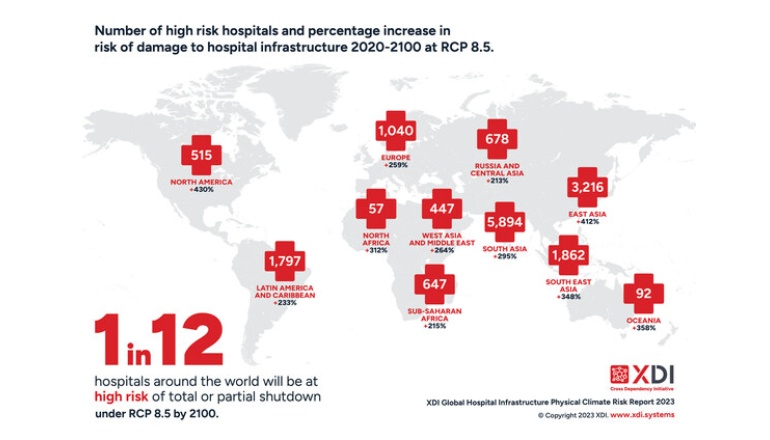Hospitals, the lifeline of citizens globally, are fighting a new pandemic!
According to a new study from Cross Dependency Initiative (XDI), more than 2 lakh hospitals globally, face the risk of shutdowns due to extreme weather.
Translated: 1 in 12 hospitals around the world could face partial or total shutdown from climate change-triggered extreme weather events by century-end if countries continue to emit unabatedly.
The statistics for India are equally harrowing. The document said in India, the proportion of hospitals at high risk of being shut down by extreme weather events would be 5.7 percent by 2050.
Translated: These events will impact almost 1 in 10 hospitals by century-end if emissions are high.
These figures tell a startling tale. They serve as a warning to the entire healthcare ecosystem.
Healthcare systems are part of the solution as well as part of the issue, bearing the brunt of providing care for those impacted by climate change. As per data, up to 4.6% of all greenhouse gas (GHG) emissions—which include ozone, carbon dioxide, and methane—are produced globally by the healthcare industry.
India’s healthcare system is diverse in ownership, size, and comfort levels, resulting in varying energy needs across different institutions. The categories include (public, insurance, municipal, railway, defense, and private hospitals, for example) and size (small clinics in rural areas to large multi-specialty hospitals), air-conditioned areas, and medical services. Hospitals, a vital industry, rely heavily on grid power for operations like cleaning, washing, and oxygen provision, ensuring constant power supply.
Climate change can significantly impact healthcare access and delivery, potentially disrupting infrastructure essential for emergency services, transportation, and communication networks.
Research also shows that heavy reliance on fossil fuels in medical cold chains negatively impacts healthcare providers, causing fuel supply issues and power outages. This exacerbates global warming, contributes to air pollution, and increases greenhouse gas emissions.
In terms of actual numbers, the pharmaceutical industry in India has the seventh-largest climate footprint in the health sector. The industry is expected to develop at a 13.4% compound annual growth rate (CAGR) until 2030, which, absent a shift to more environmentally friendly and energy-efficient alternatives, would increase both energy demand and carbon footprint.
Insights from a National Hospital Energy Consumption Survey titled: Towards Climate-smart Hospitals found the following:
• Electricity from the grid (mainly), on-site solar PV, and on-site diesel generators comprise more than 90% of hospitals’ energy supply.
• The penetration of on-site solar PV is 17% in private and 11% in public hospitals.
• Hospitals consumed ~9% of India’s “commercial” electricity consumption in FY2019-20 (i.e., 9.7 TWh/year).
• The annual Scope 2 GHG emissions of hospitals in FY2019-20 were 7.7 million tonnes of CO2. (Scope 2 emissions are indirect emissions from purchased energy)
* Hospital-level energy intensities vary significantly between and within hospital typologies, influenced by factors such as end-use equipment and behavioral energy efficiency, air-conditioned areas, medical service levels, active use hours, climate zones, service outsourcing, and patient privacy.
The Indian healthcare sector relies heavily on diesel-based gensets for energy, which is a vulnerability to climate events. Access to uninterrupted energy is crucial for the health system’s sustainability and climate-smart healthcare under the Health Adaptation Plan. It is also a vital component of the proposed framework for green (environmentally sustainable) and climate-resilient or climate-smart healthcare under the NPCCHH.

